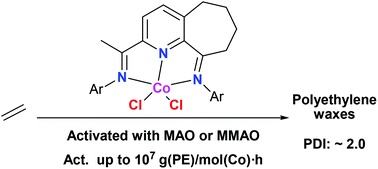Controlling the molecular weights of polyethylene waxes using the highly active precatalysts of 2-(1-aryliminoethyl)-9-arylimino-5,6,7,8-tetrahydrocycloheptapyridylcobalt chlorides: synthesis, characterization, and catalytic behavior†
Abstract
A series of 2-(1-aryliminoethyl)-9-arylimino-5,6,7,8-tetrahydrocycloheptapyridylcobalt chlorides were synthesized and characterized using FT-IR and elemental analysis, and the molecular structures of complexes Co1, Co3 and Co4 were confirmed to present a pseudo-square-pyramidal or trigonal-bipyramidal geometry around the cobalt center using single-crystal X-ray diffraction. Upon activation with either methylaluminoxane (MAO) or modified methylaluminoxane (MMAO), all cobalt precatalysts gave high activities up to the level of 107 gPE mol−1 (Co) h−1 toward ethylene polymerization, being one of most active cobalt-based precatalysts. In comparison with cobalt analogues, the title precatalysts generally possessed longer lifetime along with good thermo-stability; moreover, the resultant polyethylenes were highly linear and unimodal in most cases.


 Please wait while we load your content...
Please wait while we load your content...